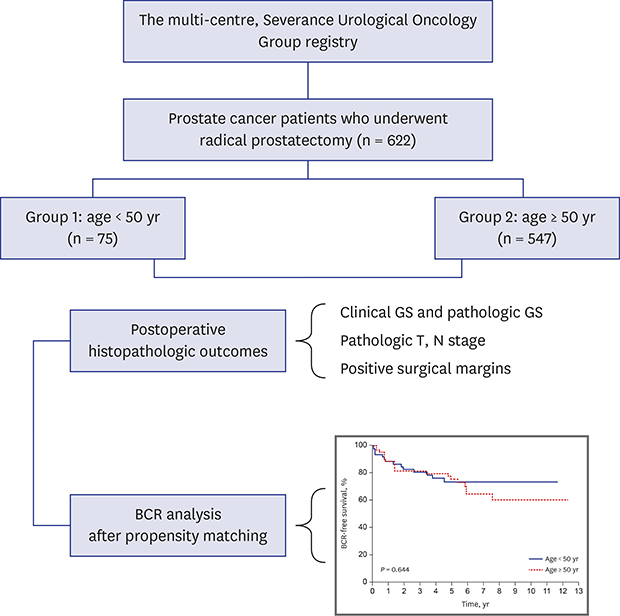1. Jemal A, Siegel R, Ward E, Hao Y, Xu J, Thun MJ. Cancer statistics, 2009. CA Cancer J Clin. 2009; 59(4):225–249.


4. Mottet N, Bellmunt J, Bolla M, Briers E, Cumberbatch MG, De Santis M, et al. EAU-ESTRO-SIOG guidelines on prostate cancer. Part 1: screening, diagnosis, and local treatment with curative intent. Eur Urol. 2017; 71(4):618–629.

5. Tjaden HB, Culp DA, Flocks RH. Clinical adenocarcinoma of the prostate in patients under 50 years of age. J Urol. 1965; 93(5):618–621.


6. Parker PM, Rice KR, Sterbis JR, Chen Y, Cullen J, McLeod DG, et al. Prostate cancer in men less than the age of 50: a comparison of race and outcomes. Urology. 2011; 78(1):110–115.


7. Becker A, Tennstedt P, Hansen J, Trinh QD, Kluth L, Atassi N, et al. Functional and oncological outcomes of patients aged <50 years treated with radical prostatectomy for localised prostate cancer in a European population. BJU Int. 2014; 114(1):38–45.
9. Man A, Pickles T, Chi KN. British Columbia Cancer Agency Prostate Cohort Outcomes Initiative. Asian race and impact on outcomes after radical radiotherapy for localized prostate cancer. J Urol. 2003; 170(3):901–904.


10. Edge SB, Byrd DR, Compton CC, Fritz AG, Greene FL, Trotti A, et al. American Joint Committee on Cancer Staging Manual. 7th ed. New York, NY: Springer;2010.
11. Gleason DF, Mellinger GT. Prediction of prognosis for prostatic adenocarcinoma by combined histological grading and clinical staging. J Urol. 1974; 111(1):58–64.


12. Johnson DE, Lanieri JP Jr, Ayala AG. Prostatic adenocarcinoma occurring in men under 50 years of age. J Surg Oncol. 1972; 4(3):207–216.


13. Smith CV, Bauer JJ, Connelly RR, Seay T, Kane C, Foley J, et al. Prostate cancer in men age 50 years or younger: a review of the Department of Defense Center for Prostate Disease Research multicenter prostate cancer database. J Urol. 2000; 164(6):1964–1967.


14. Kinnear NJ, Kichenadasse G, Plagakis S, O'Callaghan ME, Kopsaftis T, Walsh S, et al. Prostate cancer in men aged less than 50 years at diagnosis. World J Urol. 2016; 34(11):1533–1539.

15. Pompe RS, Smith A, Bandini M, Marchioni M, Martel T, Preisser F, et al. Tumor characteristics, treatments, and oncological outcomes of prostate cancer in men aged ≤50 years: a population-based study. Prostate Cancer Prostatic Dis. 2018; 21(1):71–77.


16. Thorstenson A, Garmo H, Adolfsson J, Bratt O. Cancer specific mortality in men diagnosed with prostate cancer before age 50 years: a nationwide population based study. J Urol. 2017; 197(1):61–66.


17. Bratt O, Berglund A, Adolfsson J, Johansson JE, Törnblom M, Stattin P, et al. Prostate cancer diagnosed after prostate-specific antigen testing of men without clinical signs of the disease: a population-based study from the National Prostate Cancer Register of Sweden. Scand J Urol Nephrol. 2010; 44(6):384–390.


18. Weiner AB, Matulewicz RS, Eggener SE, Schaeffer EM. Increasing incidence of metastatic prostate cancer in the United States (2004–2013). Prostate Cancer Prostatic Dis. 2016; 19(4):395–397.


19. Huang TH, Kuo JY, Huang YH, Chung HJ, Huang WJ, Wu HH, et al. Prostate cancer in young adults-seventeen-year clinical experience of a single center. J Chin Med Assoc. 2017; 80(1):39–43.


20. Song C, Ro JY, Lee MS, Hong SJ, Chung BH, Choi HY, et al. Prostate cancer in Korean men exhibits poor differentiation and is adversely related to prognosis after radical prostatectomy. Urology. 2006; 68(4):820–824.


21. Lee SE, Kim DS, Lee WK, Park HZ, Lee CJ, Doo SH, et al. Application of the Epstein criteria for prediction of clinically insignificant prostate cancer in Korean men. BJU Int. 2010; 105(11):1526–1530.


23. Lee HW, Kwak KW, Lee HM, Choi HY. The diagnostic value of predictive factors for clinically insignificant prostate cancer. Korean J Urol. 2008; 49(5):398–403.

24. Benson MC, Kaplan SA, Olsson CA. Prostate cancer in men less than 45 years old: influence of stage, grade and therapy. J Urol. 1987; 137(5):888–890.


25. Samadi DB, Sebrow D, Hobbs AR, Bernstein AN, Brajtbord J, Lavery HJ, et al. Clinicopathological, functional, and immediate oncologic outcome assessment in men aged≤50 years with prostate cancer after robotic prostatectomy. Urol Oncol. 2017; 35(1):30.e17–30.e24.

26. Adamy A, Yee DS, Matsushita K, Maschino A, Cronin A, Vickers A, et al. Role of prostate specific antigen and immediate confirmatory biopsy in predicting progression during active surveillance for low risk prostate cancer. J Urol. 2011; 185(2):477–482.


27. van den Bergh RC, Roemeling S, Roobol MJ, Aus G, Hugosson J, Rannikko AS, et al. Outcomes of men with screen-detected prostate cancer eligible for active surveillance who were managed expectantly. Eur Urol. 2009; 55(1):1–8.


28. Moyer VA. U.S. Preventive Services Task Force. Screening for prostate cancer: U.S. Preventive Services Task Force recommendation statement. Ann Intern Med. 2012; 157(2):120–134.


29. The National Comprehensive Cancer Network. NCCN Clinical Practice Guidelines in Oncology. Prostate Cancer. Version 4. Plymouth Meeting, PA: National Comprehensive Cancer Network, Inc.;2018.
30. Touijer KA, Mazzola CR, Sjoberg DD, Scardino PT, Eastham JA. Long-term outcomes of patients with lymph node metastasis treated with radical prostatectomy without adjuvant androgen-deprivation therapy. Eur Urol. 2014; 65(1):20–25.








 PDF
PDF Citation
Citation Print
Print





 XML Download
XML Download